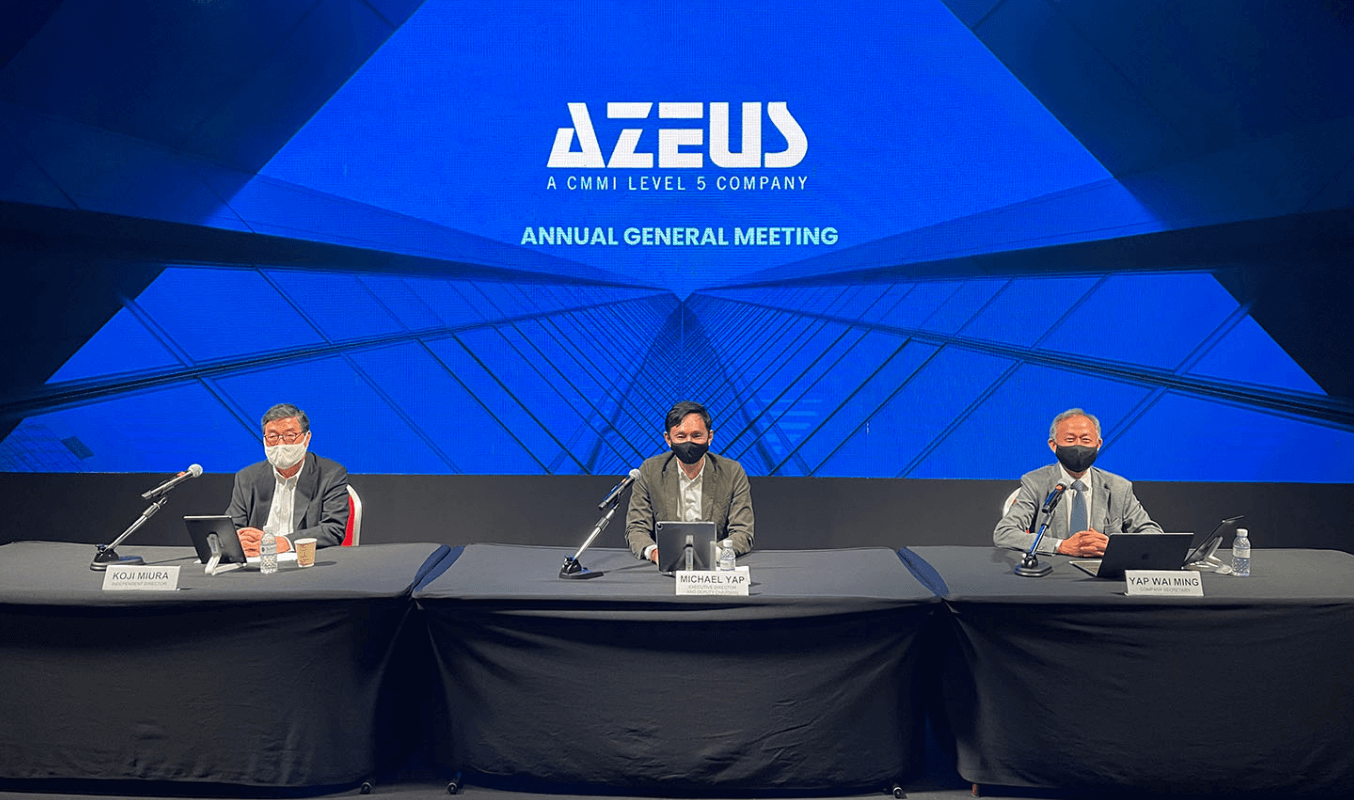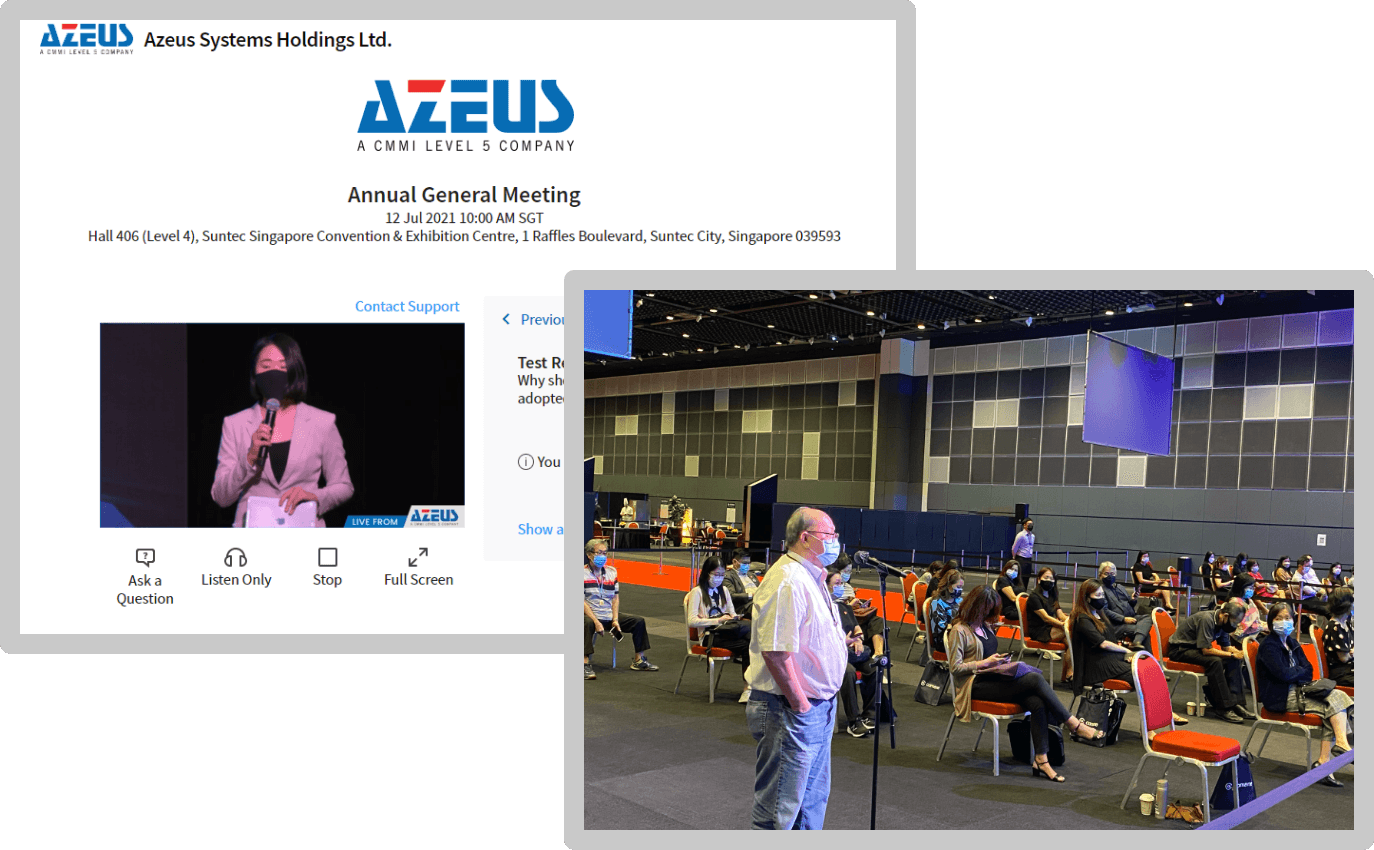Before the COVID-19 pandemic, Annual General Meetings (AGMs) were typically held in a physical venue where shareholders could directly ask questions and vote for resolutions on site. The chairperson and directors of the company had to be on the ball and be prepared for questions to come their way once spotlighted. However, in the last year, when the pandemic struck the world, everyone was pushed into an era of digital transformation. Companies now needed to hold hybrid AGMs while strengthening corporate governance.

Last July 12, 2021, Azeus Systems Limited held this year’s AGM in a hybrid format, where only a few directors and shareholders joined at the venue while the rest attended remotely. To safely follow the health protocols for onsite participants, only 50 attendees were allowed in the venue while the rest participated using the company’s in-house technology, ConveneAGM. Virtual participants were able to take part through online voting and Q&A. Through the platform, they had the option to send the queries to the board in text or video form.
A live poll at the Azeus Systems Limited 2021 AGM reflected that about 87% of the attendees fully support virtual AGMs, while the rest prefer the hybrid format. No one voted for physical AGMs in conducting future annual general meetings.

It could be inferred that people are now getting used to virtual AGMs as the new status quo, but are not entirely embracing the physical element of hybrid AGMs.
Corporate governance advocates are increasingly concerned as companies opt for virtual AGMs, which only allow one-way interaction — the Board of Directors and Chairperson are the only ones presenting or speaking while the shareholders merely observe the AGM proceedings. This quick-fix allows companies to avert the possibility of spilling underlying issues. Thus, when virtual AGMs are not practiced properly, they may not uphold some of the most important elements of AGMs, such as transparency, accountability, and security.
Hosting a virtual AGM inappropriately can serve as a free pass for the board, restricting the ability of shareholders to question companies and directors for poor practices. It limits the shareholders’ rights to raise important issues and share their sentiments on crucial matters such as environmental, social, and governance (ESG).
If virtual AGMs solely depend on a limited platform, proceedings may be reduced due to time restrictions. This may give organizers an excuse to conduct voting before or after the meeting. Meanwhile, questions may be answered only after the meeting through an official publication on the company website. In this way, shareholders will have limited access to pertinent information, such as the insights of other shareholders.
This also brings into consideration the handling of meeting access and documentation. If virtual platforms are not sufficiently optimized to employ stringent security measures on participant verification and cloud infrastructure, risks on unauthorized access to the meeting and the shared documents are heightened.
It is indeed an alarming trend that many companies are adhering to a one-sided virtual AGM for convenience. This brings in the edge of conducting AGMs in a hybrid setup where the strengths of both physical and virtual AGMs can be extracted while minimizing the downsides.
What constitutes a hybrid AGM?
A hybrid AGM allows the attendance and engagement of attendees online and within a meeting venue, constituting a hybrid meeting setup. Interaction of all physical and virtual participants is facilitated by bringing them together using a one-stop platform such as ConveneAGM, which can host the live webcast of AGM, live voting, and live Q&A.
This type of AGM solution closely adheres to key values of good corporate governance granted by physical AGMs while also offering the flexibility of virtual AGMs. International participants of the AGMs can join anywhere and anytime, even in the comfort of their homes, while shareholders who hope for more physical engagement can go to the physical venue to take part in the AGM.

About Hybrid AGM Features: What’s in it for me?
For the Companies
In a hybrid AGM, live question and live voting usually go hand-in-hand to help promote good corporate governance practices in physical AGMs. As Christopher Wong, Head of Assurance at Ernst & Young LLP in Singapore, wrote in a Business Times article, “For those who choose to see the AGM as a compliance exercise and leverage the virtual format for an “easier” dialogue, it is a wasted opportunity to engage with shareholders robustly and openly, and through that, build trust and confidence.” This will also challenge company executives to better prepare their plans and actions, knowing that it will undergo shareholder scrutiny.
AGMs are an avenue for companies to strengthen relationships with their shareholders. Positive business relationships can attract more investors and contribute to a company’s image in the industry. Live voting and live Q&A can provide shareholders the means to get them into the conversation. As mentioned in an article by PwC, ensuring that shareholders have an active role during AGMs and decision-making will help the company cultivate a strong relationship with shareholders, which can be utilized especially when the company faces difficult times.
For the Shareholders
Emphasizing the secured engagement of shareholders, hybrid AGMs provide a platform for shareholders to take part in important discussions according to their preferred channel. Based on their location and technological readiness, they may opt to attend physically or remotely. Regardless, if shareholders plan to join in the virtual or physical site, platforms such as ConveneAGM allow high shareholder participation through live voting and Q&A. In this way, directors lead not only the AGM discussions, but shareholders may steer the discourse by raising questions, clarifications, and suggestions on pertinent matters. It also opens a larger space for engagement, where shareholders can fill in their insights on aspects that the company may have overlooked in crafting its strategic plans. This can help build a strong relationship between the company and shareholders who can learn from each other.
What are the best practices for hybrid AGMs?
As it is still uncertain when health protocols against COVID-19 will be lifted worldwide, companies must ensure that AGMs are not delayed but efficiently conducted. Hybrid AGM solutions respond to the flexibility needs of participants who may either prefer to join virtually or onsite. This serves as a challenge to companies to deliver a seamless experience to participants, regardless of how they are joining the AGM.
Below is a compilation of some of the best practices in facilitating hybrid AGMs:
- Communicate the agenda and notify stakeholders beforehand.
Ensuring that participants are well-informed of the matters to be discussed, AGM organizers should verify that the agenda is disseminated to the participants. Being able to view the discussion points before the general meeting may also serve as a deciding factor for participants on whether they will attend on-site or remotely.
- Plan the logistics early and rehearse.
Planning is always advisable to ensure a seamless AGM from start to finish. It is recommended to settle the legal considerations of the AGM first. Check the provisions in the local law if your organization can hold an electronic AGM. Once confirmed, find a venue that can accommodate the number of physical attendees and the essential technical equipment for the AGM. Make sure to account also for the human resources needed in streamlining the meeting flow.
Rehearsing after planning is one key to the success of the event. This will make certain that all bases have been covered and all equipment will function as required.
- Assign a sharp moderator and technical team to facilitate the hybrid AGM.
Shareholders and other attendees must be encouraged to participate throughout the event to make the most out of the meeting. Designating a moderator who will guide the participants from one topic to the next can increase the engagement of the participants. Since the live interaction is a major edge of hybrid to virtual AGMs, the moderator and technical team supporting the event must encourage the participants to send their questions to the board. This helps increase stakeholder trust and confidence, as the current operations and plans can be scrutinized and clarified during the meeting.
- Ensure a stable internet connection for the AGM host and panelists in the venue.
The virtual aspects of an AGM in a hybrid structure rely greatly on the stability of an internet connection. Getting a point across would not be as convincing when the screen freezes every two seconds, or statements suddenly get cut off mid-sentence due to intermittent connection. This may cause delays on the AGM, which subsequently might affect the other agenda items’ time allocation in the schedule. Moreover, it could cause negative repercussions on the image of a company, considering that shareholders and other observers are present in such a large-scale event. To cover all possible mishaps, having a Plan B — like a backup internet connection — would be ideal.
- Choose an excellent platform to hold the virtual aspect of the AGM.
The most suitable platform to help your organization is one that can grant access to necessary attendees without compromising the security or efficiency of AGM. Such a solution must be able to cater to the volume of virtual attendees while also effectively accommodating AGM functionalities such as user authentication, voting, and Q&A.

How do hybrid AGMs help apply the three pillars of corporate governance?
The three pillars of corporate governance are transparency, accountability, and security. At the time of the new normal, hybrid AGMs support companies in continuously implementing the three pillars by utilizing the strengths drawn from both virtual and onsite methods.
1) Transparency
To ensure that all shareholders are well-informed and up to date, pertinent documents from the AGM, such as minutes, must be readily accessible. During the AGM, the technology to be used must be able to facilitate generating live voting results which can help the executives immediately grasp the view of the shareholders on the board’s goals and planned course of action. Moreover, the platform should also be equipped with audit trails that will provide accessible documentation of the events that transpired during the meeting. This reflects the important role of the technology to be used during the hybrid AGM, as it must have an efficient procedure for documentation and activity tracking from before until after the meeting.
2) Accountability
An advantage of the hybrid format from purely virtual AGMs is the opportunity for shareholders to conduct a live Q&A session with executives regarding their decisions and goals. According to the International Corporate Governance Network, virtual shareholder meetings may limit the opportunity for participants to get their questions acknowledged or tackled more in-depth since some practices include requesting shareholders to send their questions in advance while the directors will respond in a pre-recorded manner. In physical and hybrid format, this can be addressed through an open microphone session where shareholders can directly communicate with the executives and send follow-up questions when needed.
3) Security
Virtual and hybrid formats can implement stricter entry to AGMs through the mediation of a secure platform. As emphasized in an article by Eversheds Sutherland, meeting organizers must have a method to identify the participants joining the AGM and facilitate voting procedures. Digital solutions such as ConveneAGM are incorporated with two-factor authentication, which helps organizers verify participants upon entry using a unique security code. Voting procedures are also facilitated which may be through a show of hands or secret ballot. This also ensures that all information pertaining to the meeting can be accessed in one place.
Holding Hybrid AGMs
Overall, hybrid AGMs pave the way for an increased shareholder engagement as it breaks through geographical barriers and allows all participants to engage in relevant matters. However, one challenge it brings is ensuring that participants joining virtually and onsite will have a similarly smooth experience. This can be addressed by utilizing a reliable and secure platform to manage the participants’ entries, interactions, and information access. By employing the best practices for hybrid AGMs, it can provide shareholders with an equal opportunity to contribute to the discussion and raise their concerns regardless of their location and mode of participation. This will help increase shareholder confidence and trust as they can meaningfully contribute to setting the course of the company towards its goals and addressing the issues it faces.
Discover how you can employ the best practices for executing AGMs in a hybrid arrangement using ConveneAGM.
Louise is a Proposal Writer at Convene. Her enthusiasm for writing coupled with her experience working for IT organizations has aided her in creating content on digitalization, board portals, and virtual meetings. Aware of the IT field’s ever-growing nature, she aims to broaden her scope and cover more topics that bridge technology and businesses.

